Invaders
/6 Comments/in Flowers, Pests/by Lee ReichDare I Speak the Name?
As I was bicycling down the rail trail that runs past my back yard, I was almost bowled over by a most delectable aroma wafting from a most despised plants. 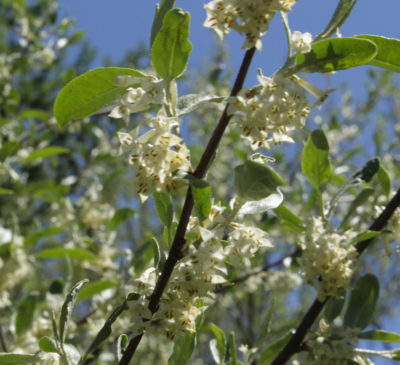 The plants were autumn olives (Elaeagnus umbellata), shrubs whose fine qualities I’m reluctant to mention for fear of eliciting scorn from you knowledgable readers.
The plants were autumn olives (Elaeagnus umbellata), shrubs whose fine qualities I’m reluctant to mention for fear of eliciting scorn from you knowledgable readers.
Yet, you’ve got to admit that the plant does have its assets, in addition to the sweet perfume of its flowers. Okay, here goes: The plant is decorative, with silvery leaves that are almost white on their undersides. And the masses of small fruits dress up the stems as they turn silver-flecked red (yellow, in some varieties) in late summer. 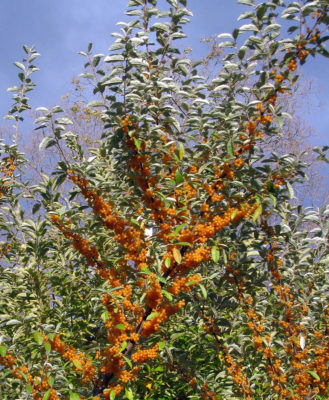 Those fruits are very puckery until a little after they turn red, but then become quite delicious, and healthful.
Those fruits are very puckery until a little after they turn red, but then become quite delicious, and healthful.
(I included autumn olive in my book Uncommon Fruits for Every Garden, and also planted them — but that was before the plant became illegal here.)
Another asset of autumn olive is that it actually improves the soil, converting air-borne nitrogen, which plants can’t use, into soil-borne nitrogen for use by autumn olives and nearby plants.
This native of Asia, introduced into the U.S. almost 200 years ago, was promoted in the last century as a plant for wildlife and soil improvement. Decades ago I worked for the USDA in what was then known as the Soil Conservation Service (now the Natural Resource Conservation Service), an agency that not only promoted the plant but also developed varieties for extensive planting.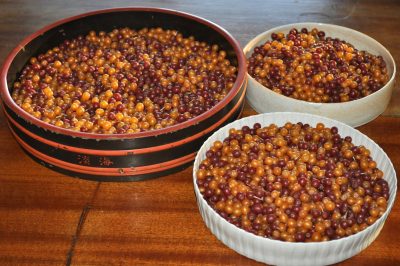
Autumn olive likes it here and has invaded fields throughout the northeast, the Pacific northwest, and even Hawaii. It’s an invasive plant. Don’t grow it! (But feel free to enjoy its aroma, its beauty, and its fruits.)
One of My Favorite “Invasives”
As autumn olive blossoms fade, the temporary vacuum in sweet-perfumed air will be filled by another plant, black locust (Robinia pseudoacacia). That aroma comes from the white blossoms that dangle in chains like wisteria blooms from this tree’s branches.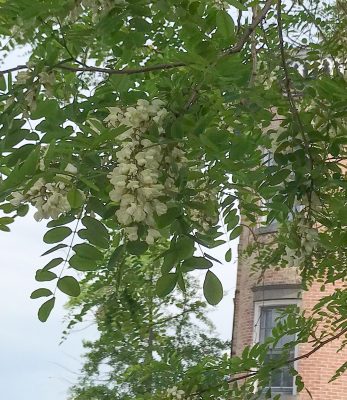
Like autumn olive, black locust has other assets in addition to those offered by its blossoms. It’s a leguminous plant, like peas and beans, so, with the help of bacteria residing in its roots, also puts air-borne nitrogen into a form utilizable by plants.
Black locust’s other assets refer to it when dead: The dense wood is very resistant to rot — much, much more so than cedar — and is very high in BTUs for burning. I converted all my garden’s fenceposts and arbors, which I had previously made from cedar and lasted only about 10 years, to locust.
I’m lucky enough to have a mini-forest of them growing along one edge of my property. I cut them when they are five or six inches in diameter, and in 10 or so years I have a new one to replace the cut one. It adds up.
Quick growth and the ability to resprout from stumps and grow in poor soil by “making” its own nitrogen makes black locust, like autumn olive, a plant not loved by everyone. Despite being native here in the U.S., black locust has been classified as a “native invasive.” The reason is that it was originally native to only two regions in the U.S., from which it has now spread far and wide.
Change Will Come
The classification of “native invasive” highlights the capricious legality and classification of invasive plants. Where is the boundary within which a plant becomes an accepted native? In the mountain that rises up just behind my valley setting, lowbush and highbush blueberry are thriving natives. But these plants would never turn up here on my land, except that I planted them. (And both thrive.)
Clove currant is another plant I grow, one that, in addition to bearing spicy fruits, is resistant to just about every threat Nature could throw at it: deer, insects diseases, cold, drought. And it’s a native plant, but native throughout the midwest, not here. Should I call it a “native?”
Black locust is such a useful tree that its spread was aided and abetted by humans. But it also would have spread, albeit more slowly, without our intervention. Even autumn olive, given enough time, might have hitch-hiked here in some way from Asia.
The Earth’s landscape is not static. Changes represent interactions of climate, vectors, chance, and time. Nostalgia may have us wishing for the view out the window to remain the same as it was when we were children, but that’s not Mother Nature’s way.
Playing Around With Stems
/7 Comments/in Design, Fruit, Gardening/by Lee ReichTop Doggery
Within any plant a push and pull goes on between fruiting an stem growth. Both require energy, which the plant has to apportion between the two. The more vigorously growing a stem, the less fruitful it is.
All this talk of hormones and inherent stem vigor is more than academic; it can translate into delicious fruits.
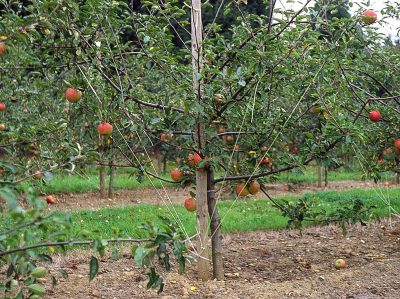
Tied branches in British orchard
But pear trees, especially in the youth, tend to put too much of their energies, too much for me, at least, into stem growth. The result is that they can take long time to settle down and begin bearing fruit.
Hence, the strings. I can change my pear trees’ habits by merely tying down branches, reducing the effect of that auxin so that growth is more uniform along a length of the stem. And, as important, slowing growth nudges the energy balance in the direction of fruiting.
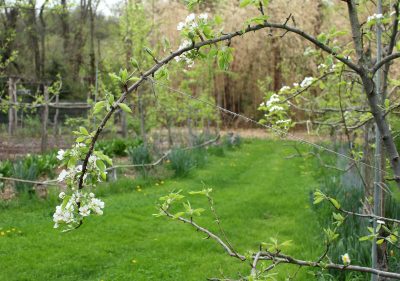
More Fruit or More Growth?
Branch bending is not only for coaxing a tree into fruiting. On young branches, it creates a wide angle between a branch and the developing trunk. Wide angles here have been shown to result in good anchorage, sturdy side branches that can carry a weight of fruit.
Suppressing the vigor of side branches also ensures that they won’t compete with the developing trunk, which needs to be top dog.
And using string to play around with plant hormones isn’t needed on every fruit tree. At the other extreme from pear in its growth and fruiting habits is peach. Peach is naturally very fecund, and becomes naturally so at a very young age.
Beauty, Fruit, and Fun
All this concern with auxin, vigor, and fruiting comes most prominently into play with espalier, which is the training of a tree to an orderly, often two dimensional form. The tracery of the branches themselves adds to the decorative value of the plant.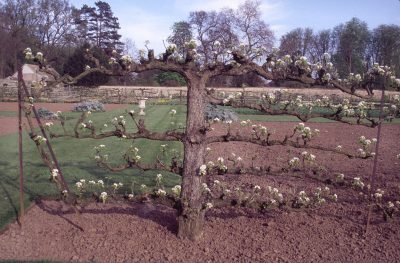
Fruiting espaliers, besides being decorative, produce very high quality fruit. Pruning and branch bending maintain a careful balance between yield and stem growth, and the form of the plant allows leaves and fruits to bathe in sunlight and air.

Bedding Down
/6 Comments/in Design, Planning, Vegetables/by Lee ReichFlat Beds
My vegetable garden is in beds. Your vegetable garden is in beds. Seems like just about everybody plants in beds these days. And with good reason. Beds make more efficient use of garden space. Soil compaction is avoided because planting, weeding, pruning, and harvesting can be done with feet in the paths. And the shapes of the beds can help make even a vegetable garden look prettier, especially with decorative plants edging the beds.
Raised beds are also one way to grow happy plants in otherwise poorly drained ground, or in ground that has been contaminated by lead or arsenic. Such contamination is likely to occur from past use of leaded gasoline near roadways, from old paint near buildings, and from residual pesticides in sites that were once orchards.
My vegetable garden is laid out in 3-foot-wide beds with 18-inch-wide paths between them that feed into one 5-foot-wide path down the center of the garden. Many gardeners, when considering planting in beds, equate that with RAISED beds. My vegetable beds are not intended to be raised even a hair above the paths.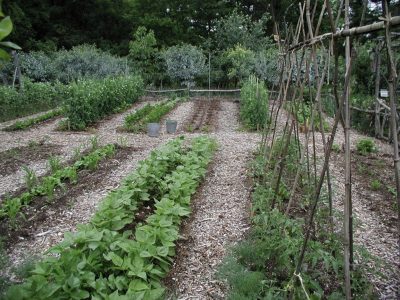
When I began my garden, I laid out the beds and covered them with compost, and then laid wood chips from local arborists in the paths. The difference in appearance of the two materials makes it easy to see where to walk and where not to walk. (For most people, that is. A well-known food writer once visited my garden. As I walked up a path, he tromped along next to me — right up the middle of the bed adjacent to the path! — until I let out a scream that brought him to an abrupt stop. Some lush plants in the bed were admittedly flopping onto the path, obscuring the difference between walking and planting areas.)
Raised Beds
Soil in raised beds is usually held there with boards or other edging. That edging material might itself be decorative: lumber, bricks, roof tiles, or, in a “colonial” garden, logs.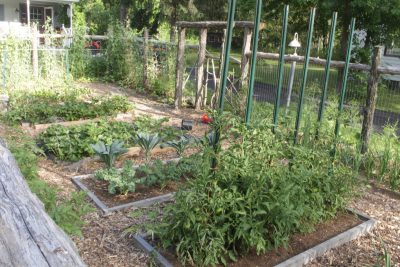
Ideally, any wooden edging is rot resistant. Locust or redwood would be my top choices, but hard to get. “Manufactured” lumber, such as Trex, is another possibility. Then again, pine or spruce boards are readily available, relatively inexpensive, and should last quite a few years.
A six-inch-high bed provides enough well-drained root depth for pretty much all vegetable plants.
One disadvantage to raised beds is that you have get soil to fill them up. That soil could, of course, come from what will be the paths. 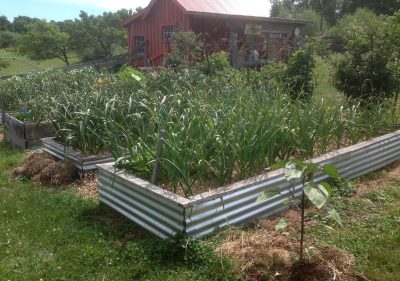 If the area is wet, though, taking soil from paths is going to lower them, making them that much wetter.
If the area is wet, though, taking soil from paths is going to lower them, making them that much wetter.
Most people bring in soil for raised beds, and, in the interest of having the best possible garden, make that “soil” compost. Not a good idea. For one thing, compost is mostly “organic matter,” meaning compounds of carbon, hydrogen, and oxygen. With time, as organic matter decomposes to nourish soil microorganisms and plants, it disappears, literally, becoming carbon dioxide and water. So a raised bed filled with compost will eventually shrink down to almost nothing.
The thing to do is to fill beds almost to their brims with any any well-drained soil. Fertility is not important; that will come from the one to two inches of compost with which the soil is topped. Replenishing the compost each year will provide all the nutrition plants need for that year; no additional fertilizer is necessary. And no need to dig or rototill the compost into the ground.
One more thing about raised beds: The improved drainage also means that they dry out faster, so benefit from irrigation.
Table-like Beds, Not
If you were to walk into my garden, you might notice that my planting beds are indeed a bit higher than the paths. This was not deliberate.
Each year for many years I’ve topped all my beds and an inch or two of compost. Paths get replenished with wood chips only if they start to get weedy or bare soil starts peeking through.
Paths get replenished with wood chips only if they start to get weedy or bare soil starts peeking through.
If it weren’t for decomposition, those yearly additions of compost would have made each bed into a “table” more than three feet high. It hasn’t. Q.E.D.

